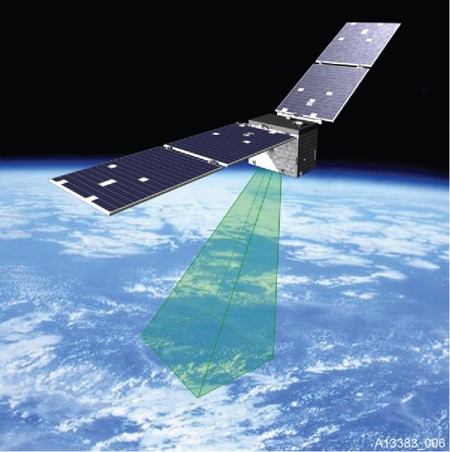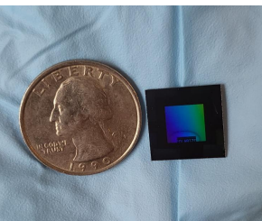Over the past four years, the research lab of Clarkson University Professor of Electrical & Computer Engineering David Crouse has been working with Phoebus Optoelectronics and Ball Aerospace on materials to enable more compact, higher-performing imaging systems for NASA satellites.

Crouse is also the president of Phoebus Optoelectronics, which he founded in 2003 to transition technologies from his research laboratories to industry. The small firm, which is located in Ithaca, N.Y., focuses on custom design and advanced materials and device development in the technology fields of metamaterials, photonic crystals, and plasmonic crystals.
Crouse’s research team is developing metamaterials, which are materials engineered to have a property that is not found in naturally occurring materials. They will be used in the NASA satellites’ hyperspectral imaging systems, which collect and process information from across the entire electromagnetic spectrum to find objects, identify materials or detect processes.
“The metamaterial filter we are developing will allow for the advanced light filtering, which is required for atmospheric sensing and monitoring, to be miniaturized from the current refrigerator-sized state-of-the-art systems to the size of a computer chip,” says Crouse. “Our chip-sized metamaterial can be custom designed for each application depending on its needs. It is much cheaper, smaller, and lighter weight, it is much more tolerant of the shocks and vibrations encountered during space flight, and it requires much less power to operate.”

The research team was first awarded a large NASA Advanced Component Technology (ACT) grant to develop a human systems integration (HSI) system for NASA’s Earth Science Technology Office. The program went well, culminating in a working prototype that demonstrated the new metamaterial’s enhanced performance.
In November, the project graduated to the next NASA program level – the Instrument Incubation Program (IIP). The IIP is starting where the ACT left, taking the technology from lab demonstration and developing it into a working instrument that can be put onto upcoming NASA missions.
The NASA grant award totals about $4.5 million award and could lead to other NASA program involvement for the Clarkson team.
“This is getting our team into the process that develops NASA’s next satellites,” says Crouse. “We are integrating functionalities that will enable technology for a whole new generation of satellites and drones. We continually develop additional NASA project proposals, always partnering with a large company partner to perform the system/instrument integration, with Phoebus and Clarkson focusing on the key innovation, namely the metamaterial chip.”
NASA is a member of the National Science Foundation Industry-University Cooperative Research Center for Metamaterials, which Crouse founded more than a decade ago, along with University of North Carolina at Charlotte Professor Michael Fiddy. The center designs, fabricates, and tests a wide range of metamaterials and has facilitated many contacts for the university researchers. “We come up with ideas as to what technology will be needed now and in the future and figure out innovative solutions,” says Crouse.
Crouse’s Clarkson team continues to work with many other large aerospace companies and governmental organizations like Ball Aerospace, Lockheed Martin, Raytheon, Raytheon Vision Systems, Harris, Teledyne, Goodrich, and AER Corporation, as well as the U.S. Air Force, U.S. Navy, U.S. Army, National Science Foundation, and the U.S. Department of Defense Missile Defense Agency and Chemical and Biological Defense Agency.
“We always have a large company partner work with us on these technology development projects,” says Crouse. “They bring a lot of commercialization experience to the table.”
Next, Crouse has proposed an interdisciplinary “Space Instrument Development Group” at Clarkson, which would bring together faculty researchers from across campus to collaborate with the University’s aerospace industry partners. The group would focus on more research into the development of next-generation space-based instruments for both NASA and commercial entities.
“One of our goals is to take project research that we are now sending off-campus and be able to perform it within our own research groups right here at Clarkson,” says Crouse.
Research experience is an important component in the education of both Clarkson undergraduate and graduate students. Electrical & computer engineering Ph. D. student Igor Bendoym, who has been working with Crouse on this research for more than a decade, will graduate in May.
“While at Phoebus, Dr. Bendoym served as the principal investigator for the NASA ACT project, gaining a level of research experience that is rare for a Ph.D. student,” says Crouse.
Bendoym first worked with Crouse as an undergraduate researcher at the City College of New York and then joined Phoebus as its main optical designer. In 2017, he joined Crouse’s academic laboratory at Clarkson as a Ph.D. student researcher, while he continued to work for Phoebus.

![Acceptable items textiles [clothing, shoesm accessories, linens, stuffed animals, no pillows] household goods [plastic dishes, utensils, hangers, lamps (remove bulbs), clocks, crates no glass/broken items], furniture [good condition (no mattresses/box springs)], new school supplies [art supplies, unused print cartridges, pens, markers, books], small appliances [hair dryers, mircowaves, iron, refrigerators, coffee makers], electronics [cell phones, printers, laptops, (electronics to recycle please label)], food [nonperishable and unopened]](https://announcements.clarkson.edu/wp-content/uploads/enjoy-your-summer.png)
